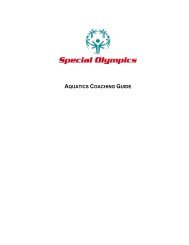BADMINTON Special Olympics Sports Skills Program
BADMINTON Special Olympics Sports Skills Program
BADMINTON Special Olympics Sports Skills Program
You also want an ePaper? Increase the reach of your titles
YUMPU automatically turns print PDFs into web optimized ePapers that Google loves.
• Limiting the intake of red meat<br />
• Avoiding between-meal and late-night snacks<br />
• Eating balanced meals regularly<br />
• Drinking at least eight (8) glasses of water daily<br />
• Getting plenty of sleep<br />
• Drinking plenty of water before, during, and after<br />
training and competition.<br />
• Taking food supplements such as vitamins, minerals, and<br />
proteins may not be necessary if proper eating habits and<br />
diet are followed.<br />
Medical Care for Injuries<br />
It is the coach’s job to maintain as safe an environment as<br />
p o s s i ble. It is strongly recommended that coaches have cert i -<br />
fi c a t i o n in cardiopulmonary resuscitation (CPR) and first aid.<br />
Athlete medical forms should be reviewed before the start of<br />
practice and be on hand at all trainings and competitions. There<br />
should be a plan for emergencies. Using the Coach’s Safety<br />
Checklist will help to prevent injury by assuring adeq u a t e<br />
s u p e rvision and the proper equipment, fa c i l i t y, wa rm-ups, and<br />
stretching exe r c i s e s .<br />
When an injury does occur, STAY CALM, and administer<br />
only basic first aid. When in doubt or when more care is<br />
needed, CALL EMS (your local Emergency Medical System)<br />
and get professional medical assistance. Also, consult the<br />
athlete’s family and/or a physician.<br />
Care for Minor Injuries<br />
Blisters<br />
• Keep pressure off new blisters using a felt “doughnut.”<br />
• Where the skin is torn, use extreme care.<br />
• Keep area clean.<br />
• Apply a sterile dressing.<br />
• When underlying tissue toughens, a dressing may no<br />
longer be needed.<br />
Abrasions and Contusions (Floor Burns and Deeper<br />
Bruises)<br />
• Keep area clean.<br />
• Expose area to the air when possible.<br />
• Keep area dry.<br />
• Encourage gentle activity.<br />
<strong>Special</strong> <strong>Olympics</strong> Badminton <strong>Sports</strong> <strong>Skills</strong> <strong>Program</strong><br />
Information to Give to the Emergency Operator<br />
1. Caller’s name (and number if available)<br />
2. Name of site and location of intersecting streets<br />
3. Injured person’s location at the site<br />
4. Type of injury and care being given<br />
Chronic Knee Pain,Thigh Muscle Overload, Tendonitis,<br />
Stress Fractures, and Ligament Strain. Follow the doctor’s<br />
directions, which will generally include:<br />
• Resting for five to seven days<br />
• Icing for pain<br />
• Stretching related muscles to strengthen them<br />
• Moving gently, stopping at the point of pain<br />
• Exercising to strengthen afflicted area as it heals.<br />
Treating Strains, Contusions, Minor Bumps and Bruises<br />
R - Rest, stop any pain-causing activity.<br />
I - Ice for 24-36 hours after the injury.<br />
C - Compress with elastic bandage if needed.<br />
E - Elevate to avoid edema and subsequent swelling.<br />
Conditions Requiring Medical Attention<br />
• Significant swelling or dislocation of an extremity<br />
• Obvious deformity of an arm or leg<br />
• Severe pain<br />
• Inability to bear weight on a lower extremity<br />
• Lacerations with or without fractures<br />
• S i g n i ficant swelling of a joint, i.e., elbow, wrist, knee, ankle<br />
• Loss of sensation in an extremity<br />
• Loss of consciousness<br />
• Heat and cold related illnesses or injuries<br />
Conditions Mandating That Only Experienced Medical<br />
Personnel Move the Athlete<br />
• Loss of consciousness<br />
• Neck or back injury with loss of sensation or motor<br />
power in arms of legs<br />
• Head injury with disorientation and/or visual changes<br />
• A possible broken bone (i.e. arm or leg).<br />
4 5

















